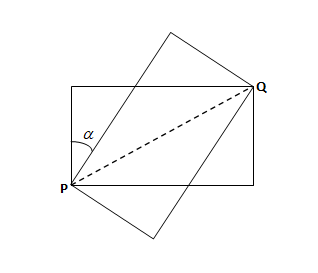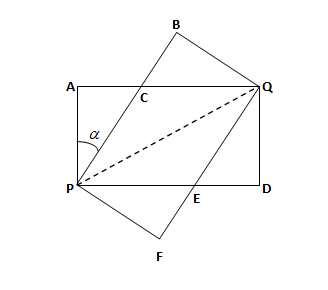Question
Question: Each rectangle is \(6\) cm long and \(3\) cm wide; they share a common diagonal of PQ. How do you sh...
Each rectangle is 6 cm long and 3 cm wide; they share a common diagonal of PQ. How do you show that tanα=43?

Solution
Here we have to find the value of α , where we will follow the rule of congruence of triangle. By which we get two triangles that are congruent. After that we will find the ratio of sides that would be equal because both the triangles are congruent. From the above step, we can see that the lines are equal also. So, we will use them to get the value of α .
Complete step-by-step answer:
First of all we will name the diagram so that it will be easy to proceed further.
So, the diagram will be as:

From the diagram, we can see that the value of α:
⇒Tanα=APAC … (i)
Since, we have some values from the question that are:
⇒AP=QD=PF=BQ=3 cm
And
⇒AQ=PD=PB=FQ=6 cm
So, the equation (i) will be as:
⇒Tanα=3AC … (ii)
For value of AC, we will follow the below procedure as:
Here, from the diagram we can say that the triangle ΔACP and ΔBCQ are congruent on the basis of Right Angle-Hypotenuse-Side rule so that we can write it as:
⇒ΔACP≅ΔBCQ
Since, we know that the triangle ΔACP and ΔBCQ is congruent. So, the sides are equal as:
⇒AC=BC
And
⇒CP=CQ
Since, ΔACP is a right angle triangle, we will use Pythagoras Principle as:
⇒PC2=AP2+AC2 … (iii)
Since, we can see from the diagram that:
⇒AQ=AC+CQ
Since, It is given that AQ=6, the above equation will be as:
⇒6=AC+CQ
We can get the value of CQ in the term of AC as:
⇒CQ=6−AC
Since, we know that CP=CQ from the congruent rule. So, the above equation will be as:
⇒PC=6−AC
Now, put the value of PC in the equation (iii). So we will get the equation (iii) as:
⇒(6−AC)2=AP2+AC2
Here, we will open the bracket by using formula (a−b)2=a2+b2−2ab , the above equation will as:
⇒62+AC2−2×6×AC=AP2+AC2
Here, AC2 will be cancel out and the above equation can be written as:
⇒62−12AC=AP2
Since, we have AP=3, then the above equation would be:
⇒62−12AC=32
Now, we will do the required calculation:
⇒36−12AC=9
⇒36−9=12AC
Here, we chance the place of equation as:
⇒12AC=36−9
⇒12AC=27
⇒AC=1227
⇒AC=49
Since, we got the value of AC , we will apply it in equation (ii)
⇒Tanα=349
The above equation can be written as:
⇒Tanα=49×31
⇒Tanα=43
Hence, we had the value of α as Tanα=43 .
Note: Here, we will check that the solution is correct or not in the following way:
Since, we have the value of αfor the triangle ΔACP from the solution that is:
⇒Tanα=43 … (1)
In the triangle ΔACP , we know that:
⇒Tanα=APAC … (2)
From the equation (1) and (2) , we have:
⇒APAC=43 … (3)
This implies that –
⇒AC=3
And
⇒AP=4
But given that
⇒AP=3
That means the above value is wrong. So we will multiply by 33 in equation (3) :
⇒APAC=43×33
We can write the above equation as:
⇒APAC=343×3
⇒APAC=349
Now, we have the correct values as:
⇒AC=49
And
⇒AP=3
